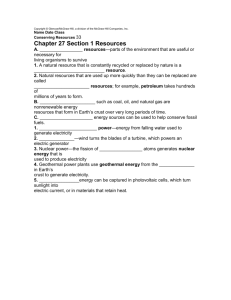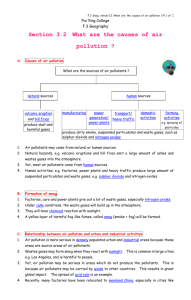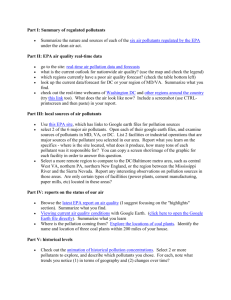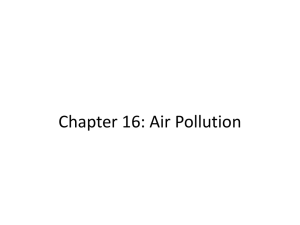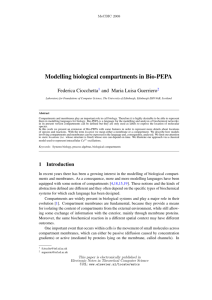Ch. 3 Environmental Problems
advertisement
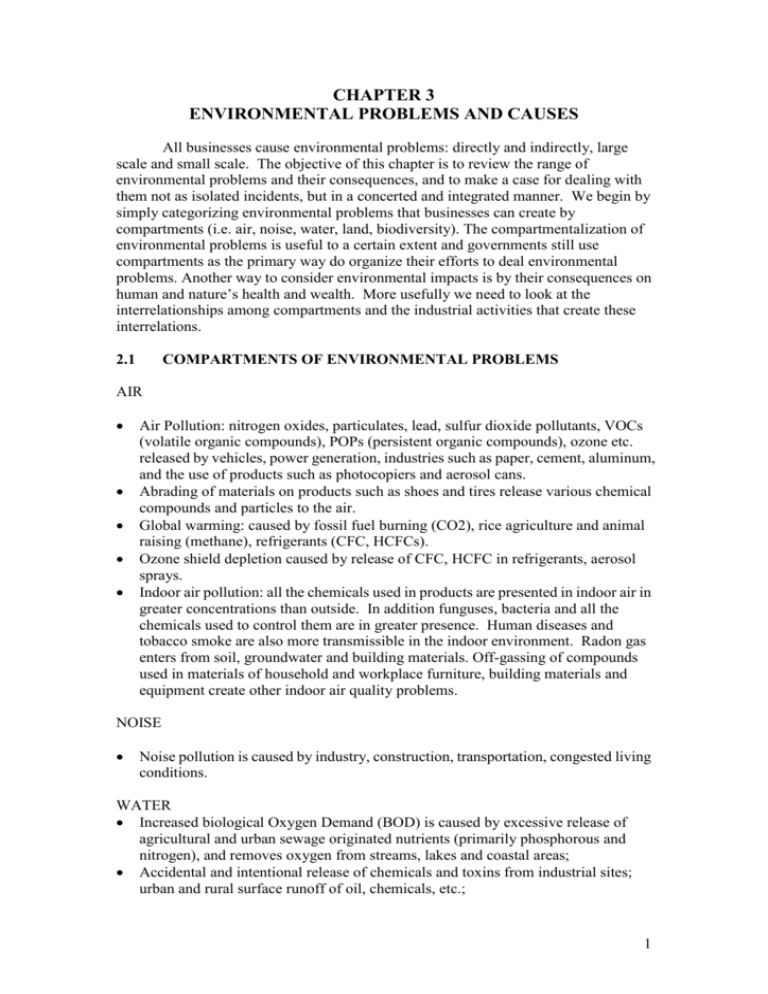
CHAPTER 3 ENVIRONMENTAL PROBLEMS AND CAUSES All businesses cause environmental problems: directly and indirectly, large scale and small scale. The objective of this chapter is to review the range of environmental problems and their consequences, and to make a case for dealing with them not as isolated incidents, but in a concerted and integrated manner. We begin by simply categorizing environmental problems that businesses can create by compartments (i.e. air, noise, water, land, biodiversity). The compartmentalization of environmental problems is useful to a certain extent and governments still use compartments as the primary way do organize their efforts to deal environmental problems. Another way to consider environmental impacts is by their consequences on human and nature’s health and wealth. More usefully we need to look at the interrelationships among compartments and the industrial activities that create these interrelations. 2.1 COMPARTMENTS OF ENVIRONMENTAL PROBLEMS AIR Air Pollution: nitrogen oxides, particulates, lead, sulfur dioxide pollutants, VOCs (volatile organic compounds), POPs (persistent organic compounds), ozone etc. released by vehicles, power generation, industries such as paper, cement, aluminum, and the use of products such as photocopiers and aerosol cans. Abrading of materials on products such as shoes and tires release various chemical compounds and particles to the air. Global warming: caused by fossil fuel burning (CO2), rice agriculture and animal raising (methane), refrigerants (CFC, HCFCs). Ozone shield depletion caused by release of CFC, HCFC in refrigerants, aerosol sprays. Indoor air pollution: all the chemicals used in products are presented in indoor air in greater concentrations than outside. In addition funguses, bacteria and all the chemicals used to control them are in greater presence. Human diseases and tobacco smoke are also more transmissible in the indoor environment. Radon gas enters from soil, groundwater and building materials. Off-gassing of compounds used in materials of household and workplace furniture, building materials and equipment create other indoor air quality problems. NOISE Noise pollution is caused by industry, construction, transportation, congested living conditions. WATER Increased biological Oxygen Demand (BOD) is caused by excessive release of agricultural and urban sewage originated nutrients (primarily phosphorous and nitrogen), and removes oxygen from streams, lakes and coastal areas; Accidental and intentional release of chemicals and toxins from industrial sites; urban and rural surface runoff of oil, chemicals, etc.; 1 leaking from mines, septic systems, underground tanks, waste disposal areas; Fallout of air pollutants; agricultural chemical usage. LAND Landfill: the burial of waste consumes significant amount of land and poses risks of leakage to surrounding soil and water tables. Hazardous wastes: Most of the world’s thousands of hazardous waste sites are locations where chemical wastes were inappropriately dumped. Nuclear waste: so far all nuclear waste is temporarily stored in above ground or below ground facilities—none have been determined to be completely safe. Abrading of materials on products such as shoes and tires allow various chemical compounds and particles to be deposited on and penetrate soil. LIFE 2.2 Habitat destruction: deforestation, desertification, wetlands destruction, coral reef destruction, salinization, erosion and soil loss. Over exploitation: of the fisheries, other animals, wood resources etc. Alien species: the diffusion of animal, plant and fungi species from one ecosystem to another. Pollution: release of pollutants into air, land and water environments. Global warming: change of ecosystems. CONSEQUENCES OF ENVIRONMENTAL PROBLEMS Human Health o Toxic: The normal functioning of the bodies respiratory, neurological, digestive, endocrine, skeletal etc. systems can be upset by a variety of chemicals used or produced in business activities. These include: heavy metals (mercury, lead, cadmium, etc.); organic compounds (e.g. volatile organic compounds [VOCs] and persistent organic pollutants [the POPs dirty dozen are the eight pesticides aldrin, chlordane, DDT, dieldrin, endrin, heptachlor, mirex, and toxaphene, the two types of industrial chemicals called polychlorinated biphenyls (PCBs) and hexachlorobenzene and the two chemical families of unintended by-products of the manufacture, use, and/or combustion of chlorine and chlorine-containing materials (dioxins and furans)]; particulates (e.g. asbestos and nitrogen oxides); and oxides such as ozone. o Carcinogenic: Cancer is caused by many of the pollutants above and several others. o Radioactive: Radioactive materials are used in most industries including food irradiation, electricity generation, medical treatment and diagnosis, industrial applications, product sterilization, consumer products, etc. The release of radioactive isotopes can cause mutations in the genetic material affecting a person (a source of cancer) and can cause mutations to reproductive genetic material and thus affect future generations. o Stress: resulting from noise and other irritants and causing lack of sleep, loss of hearing, psychological well being and immune system capicities. o Increased exposure to UV radiation cause by ozone shield depletion. 2 o Increase in disease caused by global warming. Human Wealth o Resource depletion: renewable (forests, agriculture, fisheries), non-renewable (carbon fuels, metallic and non-metallic minerals, soils, biodiversity), and possible future resources (e.g. pharmaceutical or genetic). o Environmental degradation: ecosystem services (air and water supply and purification, stability of weather and climate, soil creation and purification, pollination, watershed functions and flood control, control of pests, etc.) and amenities (recreation and aesthetic). o Economic and social disruptions from resource scarcities and changing environmental patterns; leading to political confrontation Nature's health: Nature is affected by all the pollutants that affect man, but usually to a greater extent because many of the pollutants are applied directly against nature for the control of pests or to manage it for human purposes and because humanity shields itself from many of the pollutants while nature is usually left to feel the impact. In addition to sharing the same environmental impacts as humanity, however, nature also suffers the following: o The biogeochemical balance of nitrogen, carbon, etc. is upset. o Biodiversity losses: genetic, species, and ecosystem. o Quantitative losses of life 3.3 INTERRELATIONSHIPS OF ENVIRONMENTAL PROBLEMS Sources, Sinks, and Flows The environmental compartments of air, water, land and the biosphere are also called sources because they provide all of the raw materials that we need to maintain our civilization. We, for example, extract fish, seaweed, salt and a few other resources from the sea; almost all of our mineral and fossil fuel resources come from the land (or lithosphere); the vast majority of our food and wood supply comes from the biosphere; and last but not least our oxygen comes (directly) from the atmosphere. Some environmental problems are caused by extraction of resources such as oil, timber, fish, minerals, etc. These sources of materials and energy are either non-renewable (e.g. oil) or can be maintained as renewable (e.g. timber, soil). When timber, soil or other renewable resources are exploited beyond their ability to regenerate themselves they become non-renewable and are often said to be ‘mined.’ The environmental compartments are also the sinks in which we dump our waste and expect it to be stored and/or cleansed. The oceans and its biotic life, for example are expected to clean our sewage, the atmosphere to disperse and clean the pollutants we project into it, and the ground and its living creatures is expected to take and cleanse all sorts of contaminants. These compartments, however, can only serve these functions to a threshold. After reaching that threshold their capacity to store and cleanse our waste may degrade or be destroyed. These compartments and their functions cannot of course be separated. Nature constantly cycles elements and nutrients between them in the form of the hydrologic cycle, the carbon cycle, the phosphorous cycle, the nitrogen cycle and so on. These 3 compounds constantly change from solid to liquid to gas as they cycle through the different compartments. Some such as water act to carry pollutants from one sphere to another: rain captures sulfur released into the atmosphere, brings it down to the ground, where it can be held, infiltrate into the water table or flow into rivers, lakes and oceans. The different compartments hold different materials for different lengths of time. The atmosphere cycles elements and compounds rather quickly, while the lithosphere may capture them for thousands of years. We notice the effects of the transfer of pollution rather quickly, utilizing these natural dispersers to remove our pollutants and paying the consequences when they don’t. One of humanity’s greatest impacts on the earth has been to double the amount of nitrogen cycling through the different compartments. The production of artificial fertilizers has brought about this result. Perhaps humanity’s greatest impact, however, has been to change the amount of time that carbon stays in the lithosphere as fossil fuels and in the biosphere as plant matter, and to allow it accumulate in the atmosphere at unprecedented levels. Space and Time Dimensions Environmental impacts also have space and time dimensions. An impact such as noise may be localized and short lasting. Green house gases (e.g. carbon dioxide, methane) are released into the atmosphere for global dispersion and can remain there indefinitely. Local and global impacts can occur simultaneously, although with different intensities. Radioactive release from a nuclear plant like Chernobyl, for example, may have intense local impacts that can last generations if not thousands of years. The impact will lose its intensity as wind disperses the radiation over the globe and allowing people to take less drastic and less long lasting remedies to the impact. Local and regional ecosystems are usually defined by a watershed (the area drained by a river) or by some other parameters that create unique conditions for life. These ecosystems vary greatly in their ability to assimilate pollutants or sustain exploitation and must have their particular qualities taken into consideration. Synergistic and Cumulative Affects Some environmental problems are created through the combination of a few agents, sometimes with the addition of sunlight or other forms of energy, such as photochemical smog created by NOX, hydrocarbons, and sunlight or the increased lung damage caused by the combination of inhaling both particulates and sulfur dioxide. Many toxins such as lead or mercury will be stored in the body and accumulate to a significant level before they begin to have an effect. These toxins may be passed from one species to another up the food chain in ever-greater concentrations (e.g. people becoming poisoned with mercury by eating swordfish eating fish which have eaten many fish with low levels of mercury). This type of accumulation is known as bioaccumulation or biomagnification. Point and Area Sources Pollution can be traced to singular point sources such as smokestacks or drainpipes or to areas such as farmers’ fields, urban areas, or cars and trucks. Point sources are much easier to identify and to deal with. Their most toxic effects have been treated with so called ‘end-of-pipe’ solutions, where at the point of emission (a smoke stack, a sewage outlet, etc.) some sort of device captures the pollutant for treating and transfer to another location. Area sources are much more difficult to deal with because many more people are involved, several thousand points of emissions may be involved, the costs and difficulties of making changes much greater. 4 3.4 The Interrelations of Businesses and Industries A large difficulty with focusing on specific environmental problems or even each of the environmental compartments is that environmental problems are related to each other through product and industry interdependencies. A problem is produced not only by a specific pollutant but also by the role that pollutant plays in the industry. In other words, we need to understand what role pollution or an extracted resource plays in an industry to understand how that problem can be reduced. In table 3.i below we can see that any industry produces a diversity of effects across all environmental compartments. What the table doesn’t explain is that many of the effects in any industry are interrelated and that the attempt to solve one will have repercussions on another activity of the industry. Table 3.ii, by breaking down effects throughout the product life-cycle begins to give some indication of these interrelations. A greater challenge is to fully comprehend how these interrelations affect each other as depicted in figure 3.i. The rest of the course attempts to explain these interrelations and how environmental improvements can be integrated among them. Table 3.i Environmental Impacts of Selected Industries Compartment Mining Metals Air Particulates from Particulate, gas surface mining & emissions during transportation; forging, working, noxious & toxic fabrication fumes from smelting Water Runoff from mines Discharge of and waste disposal pickling liquors & other waste disposal; heavy metals Land Dumping of tailings Slag, waste & processed products from wastes; disruption processing of agriculture, forestry, recreation Human Health Heavy metals, Toxicity particulates Petrochemicals Noxious and toxic emissions from refining, processing plants Factory emissions to water bodies Landfill disposal of waste solids & sludges; accidental spills during transport & storage Toxicity and disruption of lifestyle 5 Table 3.ii Environmental Impacts across the Product Lifecycle in the Food Industry Compartment Food Food Distribution Consumption Production Processing (use)/Diposal Air Exhaust, wind Exhaust, CO2, NOX, Noxious blown noxious others fumes chemicals, soil fumes Water Chemical Organic and Runoff from Organic and runoff inorganic roads inorganic sewage sewage Land Depletion, Uncomposted Habitat loss, Uncomposted erosion, organics and contamination organics and contamination, other wastes other wastes Habitat loss to landfill to landfill Human Toxins, Toxins, Respiratory Indoor air, health carcinogens, carcinogens, diseases Toxins, reduced reduced carcinogens, nutrition nutrition reduced nutrition 6 Parts Manufacture Materials Processing Product Assembly Resource Extraction Recycling Social Infrastructure Industry Associations, Gov’t, NGOs, etc. Distribution Physical Infrastructure roads, sewers, electricity, land Consumption use, etc. Materials Collection Material & Energy Inputs Pollution Outputs Figure 3.i Product Cycle and Industrial Ecology of an Industry Further Reading These readings give useful introductions to this complex and vast topic: Greadel T.E. and B.R. Allenby 2003. Industrial Ecology 2nd Edition. Upper Saddle River: Prentice Hall. Chapter 1 Humanity and the Environment Roberts, Peter 1995. Environmentally Sustainable Business: Local and Regional Perspective. London: Paul Chapman Publishing. Chapter 2 Environmental Problems and Opportunities 7




